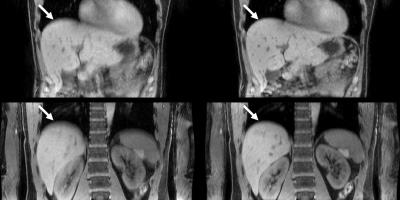4005
Improved reconstruction of free breathing abdominal imaging using non-Cartesian iterative reconstruction and elastic image registration1Philips Research Europe, Hamburg, Germany
Synopsis
Stack-of stars k-space trajectories following the golden angle scheme allow retrospective binning and reconstruction of data acquired from free-breathing patients, which is of particular interest in abdominal applications. Here we demonstrate that using an iterative non-Cartesian reconstruction in combination with an elastic registration algorithm produces images with high image quality for all motion states, regardless of the degree of under-sampling in the reference motion state.
Purpose
k-space data acquired using the stack-of-stars sampling method with golden angle profile increments [1] allows retrospective grouping of the raw data into motion states [2], [3]. Each of these raw data groups may be reconstructed separately to produce single motion state images, which can be fused subsequently, using an elastic image registration step in the combination to reduce motion artifacts in the result. However, depending on the total amount of acquired profiles and the desired number of motion bins, the available profiles per bin may be insufficient to fulfill the Nyquist criterion. Standard gridding reconstruction may result in streaking artefacts and due to the low number of profiles in poor signal-to-noise ratio. Motion resolved reconstruction methods like XD-GRASP [4] use the correlations between motion states to reduce the steaking artifacts, however are computationally very intensive. In this proof of principle study, we propose a simplified approach using parallel imaging non-Cartesian iterative reconstruction implementation [5] for streaking artefact reduction instead, prior to the above mentioned elastic image combination.Methods
3D stack of stars acquisition was used, with Cartesian phase encoding in slice (FH) direction and radial sampling in-plane. A gradient echo sequence was used with TR = 4.3 ms, TE = 1.3 ms, and 10° flip angle. In vivo abdominal images were obtained on a Philips Ingenia 3T scanner with a 12 channel posterior and a 16 channel anterior coil from a healthy volunteers, with a FOV of 450 × 450 × 252 mm³ and 1.5 × 1.5 × 3 mm³ voxel size. Golden angle radial sampling scheme was used where the angle increment between two successive readouts is given by 111.25°. 750 profiles per slice were acquired from free breathing subjects during a total acquisition time of 3 minutes. The data processing flow is summarized in figure 1. The acquired radial profiles are sorted into four motion states, using a k0 auto-navigator [6] and profiles from each motion state were reconstructed individually. The k-space data is reconstructed using either non-Cartesian iterative reconstruction with L1 regularization constraint or with a standard gridding reconstruction. Finally, a modified non-rigid, non-parametric registration method consisting of elastic registration steps was applied to generate motion-corrected image volumes [7]. Image data from one bin is used as reference and the data from the remaining bins is registered onto the reference. This process is repeated such that each motion state has served as reference.Results
Blurring of anatomical details is clearly reduced after processing the acquired data with the proposed processing (c.f. fig. 2) compared to reconstruction without binning. The image fusing after registration maintains the SNR. The reconstruction result of the iterative reconstruction shows strongly reduced streaking artefacts even in highly under-sampled motion bins (c.f. fig. 3). Simultaneously, the reduced in-plane streaking enhances through plane image quality. Combination in image space after elastic registration improves the SNR for both reconstruction types, however, streaking remains more pronounced in the gridding reconstruction (c.f. fig. 4). Finally the combination for the separate motion bins is shown side by side in figure 5. Reduced streaking in the iterative reconstruction result allows application of the registration algorithm using even highly under-sampled motion states as reference. Reference with high streaking level limit the application of the registration (not shown).Discussion
Parallel imaging of non-Cartesian sampled data with iterative reconstruction enhances the image quality of highly under-sampled radial datasets. Thereby enabling robust motion morphing using arbitrary respiratory states as reference and subsequent image combination, resulting in increased SNR and reduced streaking artefacts. The proposed technique can produce high quality image volumes of any desired motion state, even if this motion state contains only a limited number of radial profiles. In the shown example the acquired data was sorted into four states to demonstrate the feasibility of this technique. However, in general more motion states may be used to increase the temporal resolution of the breathing motion. The technique employs correlations between different states but comes with a reduced computational cost and memory requirements compared to XD-GRASP.Acknowledgements
No acknowledgement found.References
[1] S. Winkelmann, T. Schaeffter, T. Koehler, H. Eggers, and O. Doessel, “An Optimal Radial Profile Order Based on the Golden Ratio for Time-Resolved MRI,” IEEE Trans. Med. Imaging, vol. 26, no. 1, pp. 68–76, Jan. 2007.
[2] T. Schäffter, V. Rasche, and I. C. Carlsen, “Motion compensated projection reconstruction,” Magn. Reson. Med., vol. 41, no. 5, pp. 954–963, May 1999.
[3] A. C. Larson et al., “Preliminary investigation of respiratory self-gating for free-breathing segmented cine MRI,” Magn. Reson. Med., vol. 53, no. 1, pp. 159–168, Jan. 2005.
[4] L. Feng, L. Axel, H. Chandarana, K. T. Block, D. K. Sodickson, and R. Otazo, “XD-GRASP: Golden-angle radial MRI with reconstruction of extra motion-state dimensions using compressed sensing,” Magn. Reson. Med., vol. 75, no. 2, pp. 775–788, Feb. 2016.
[5] M. Uecker et al., “ESPIRiT—an eigenvalue approach to autocalibrating parallel MRI: Where SENSE meets GRAPPA,” Magn. Reson. Med., vol. 71, no. 3, pp. 990–1001, Mar. 2014.
[6] G. Cruz, D. Atkinson, C. Buerger, T. Schaeffter, and C. Prieto, “Accelerated motion corrected three-dimensional abdominal MRI using total variation regularized SENSE reconstruction,” Magn. Reson. Med., vol. 75, no. 4, pp. 1484–1498, Apr. 2016.
[7] S. Kabus and C. Lorenz, “Fast elastic image registration,” in Medical Image Analysis For The Clinic - A Grand Challenge, 2010, pp. 81–89.
Figures




